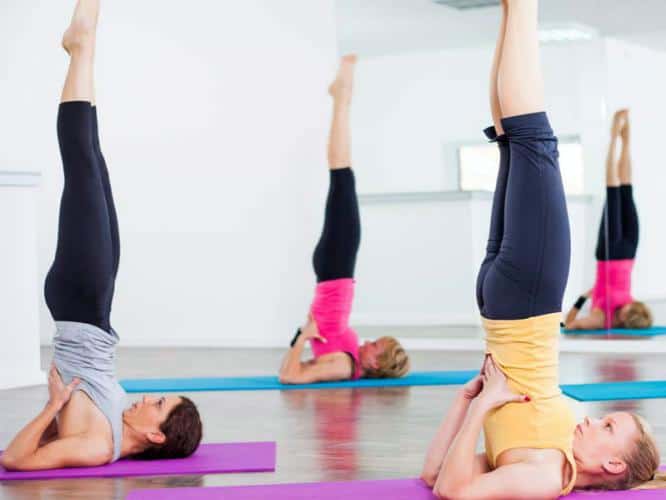Shoulder Stand or Sarvangasana :
There has always been a hype about the Headstand posture (Sirsasana) which is also known as the ‘King’ of all yoga asanas. There is no doubt about its reference because it offers magical benefits to your body.
However, there is another yoga asana referred to as ‘Queen’ or ‘mother’ of all asanas. It goes by the name of Sarvangasana or famously known as the Shoulder Stand.
Sarvangasana, also known as the Shoulder Stand, is a yoga pose wherein the weight of your whole body is balanced on your shoulders. In literal terms, ‘Sarv’ means ‘All’, ‘anga’ means ‘Part of a body’. As the name indicates, Sarvangasana enhances the functioning of all body parts.
Sarvangasana is an advanced approach to yoga that is also heavily packed with many health benefits. It is an attitude of total body training.
Why is Sarvangasana or Shoulder Stand called the Queen or Mother of all Yoga Asanas?
Have you ever wondered why the Shoulder Stand gets such distinguished recognition and praise?
What is so special or distinctive about this particular posture?
It is known as the mother of all yoga poses for a reason. The reason being your entire body is engaged when the asana is performed. As a result, it greatly influences the functioning of all the body parts.
But why the mother of all asanas?
Just as a mother is the herald of peace and harmony at home. Similarly, a regular practice of shoulder stand creates unison and harmony in the nervous and endocrine system.
What is the best time to practice Sarvangasana?
Ideally, this asana must be practiced first thing in the morning or at least 4 to 6 hours after a meal. Also, your stomach must be empty when you practice this asana.
Strengthening exercises to perform before Shoulder Stand (Sarvangasana)
Before you perform Sarvangasana, you need to strengthen your abdominal and lower back muscles by performing the following exercises.
Single Leg Raise exercise –
- Lie flat on your back, bringing your feet together.
- Then, keep your chin towards your chest in order for the neck to stay on the ground.
- Inhale as you lift your right leg up, keeping the toes pointing towards your head.
- Soon after, as you exhale out, lower your leg down slowly.
- Similarly, repeat this exercise with your left leg. Repeat this 3 times on each leg.
Double Leg Raise exercise –
- Remain flat on your back with your feet together and lower back flat against the floor, and your chin towards the chest.
- As you inhale, lift both your legs up forming a right angle.
- Then, as you exhale out, slowly lower your legs down to the ground.
- Repeat this exercise 5 times, working up to 10 double leg raises.
Festive Season Fitness – Top 5 Tips
How to do Sarvangasana or shoulder stand?
Soon after you have strengthened your abdominal and lower back muscles, you can practice Shoulder stand pose without any difficulty. It is essential and important to relieve yourself from any spinal stiffness before you perform this pose. Here’s how to get into the pose –
Thus, follow every step mentioned below to get into the pose with ease.
Step 1
Lie flat on your back, bring your feet together and stretch your arms behind your head to make sure there is space. While practicing shoulder stand make sure there is a foot or 30 cm space between the wall and your fingertips when you extend your arms.
Return the arms to the floor keeping them next to your hips with palms touching the yoga mat. Keep your head centered and breathe rhythmically in your abdomen.
Step 2
While your head and neck are on the mat, inhale and lift your straight legs at a 90 degree angle.
Step 3
Bring your hands onto your buttocks. Gently use your hands to push your body up by walking your hands down the back. Do not jump into the position by jerking your body up. The hands should support your body with thumbs outwards and fingers inwards on your waist. See above pic to understand clearly.
Breathe slowly into your abdomen and relax your legs and feet as much as possible. Remember to keep your head centered.
Step 4
Continue lifting your body until your legs are in a straight line with toes pointing at the ceiling. Take the help of the elbows to stand on your shoulders.
Step 5
Try and bring your chest as close to the chin as possible. Press your chin into the base of your throat and lock it in a chin-lock called ‘jalandhara bandha’. Breathe normally while in this position. Keep breathing and stay in the posture for 30 seconds gradually increasing the time to 3 minutes.
While practicing shoulder stand pose the back of the neck, the posterior part of the head and shoulders are to touch the floor. make sure your body is not shaking or moving to and fro. Keep the legs straight. Concentrate on your thyroid gland found in the front lower part of your neck.
If you feel calf muscles tighten or starting to cramp – bend your knees a bit to ease off the tension. Having done that for a few seconds come back to the straight leg position again.
If you are an intermediate or advanced student try and straighten your back as much as possible. Time again bring your elbows and hands closer to each other.
How do you come out of this position?
- First, lower your feet to a 45-degree angle over your head.
- Then, bring your hands to the floor, palms facing down. Concentrate on keeping your head on the ground.
- Without lifting your head, slowly roll out of the position vertebra by vertebra.
- Breathe normally until you touch your pelvis to the floor and then exhale using your abdominal muscles to lower your legs slowly to the floor. While doing so your knees should be straight.
- After the body is completely on the floor relax and rest in the Corpse Pose (Savasana) for a minimum of 60 seconds. Don’t get up with a jerk instantly after finishing it.
Mindful Eating Techniques for Weight Loss
Common Mistakes – Shoulder Stand
Shoulder stand or Sarvangasana is not an easy pose to perform. It takes hours of practice and determination to perfect the pose.
Thus, in the process, you will make a number of mistakes while practicing the pose. Therefore, these are some of the most common mistakes that yoga beginners commit at the start of their yoga practice.
In order to avoid them, I have mentioned them below, so that while practicing shoulder stand you can keep these in mind. Some of them are:
- Firstly, keep in mind that your knees should not be bent.
- Your feet should not be separate but aligned together.
- Be aware that your hips should not rotate outwards while practicing the pose.
- A very common mistake is when your entire body is leaning on one side due to uneven proportioned weight. If you have a problem or find it difficult to balance, use the support of a wall until you are comfortable with balancing your weight.
- Most of the time, the body is not straight or in position and also not relaxed. Keep your body straight but do not be stiff when you are in position.
Who should avoid doing Shoulder Stand?
- Students with a pronounced vertebral bump between the lowest cervical and the highest thoracic vertebra at the level of T1 are recommended to spread a blanket beneath them.
- Students with neck problems please consult your physician before trying this posture.
- In case of high blood pressure avoid holding this posture for more than 30 seconds.
- During menstruation either skip this posture altogether or just hold it for 15-30 seconds.
- If you are suffering from the following ailments, you definitely should avoid practicing shoulder stand: diarrhea, headaches, heart problem, glaucoma, slip disc, acute hyperactive thyroid, spondylosis and neck injury.
- If you have mastered this pose, you can also practice this asana late into your pregnancy. However, avoid to begin practicing the Sarvangasana after you have become pregnant.
- Children under 14 years of age should not hold the position for any length of time.
BENEFITS OF SARVANGASANA
Since Sarvangasana has been put on a pedestal as the Mother of all yoga asanas, it has to offer numerous benefits for your body, mind, and soul. This asana reaps with multiple physical and mental benefits. Such as:
Physical Benefits:
- The thyroid is a very important gland of the endocrine system. Shoulder stand gives it a good supply of blood. It tones and revitalizes the parathyroid and thyroid glands. As a result, it improves and balances the metabolism of each and every cell in the body.
- The ligaments of the cervical area get stretched in this exercise.
- There is fresh and good blood supply to the roots of the spinal nerves.
- Shoulder stand or Sarvangasana stretch the deltoid, supraspinatus and infraspinatus of the shoulder muscles. All the stress in the shoulder area and neck are is released.
- When you do the chin-lock the chest exerts and extra pressure on the thyroid.
- Since the body is mostly inverted the venous blood flow doesn’t stagnate in the lower limbs helping the blood to re-circulate. It is the best remedy for those of you who stand all day and have a tendency towards varicose veins. It certainly helps relive the pain of varicose veins.
- The posture of shoulder stand enhances deep abdominal breathing since it constricts the use of the top potion of the lungs.
Mental benefits:
- It makes your head clear in its thinking by removing mental sluggishness.
- Cures depression and boosts cheerfulness.
Best time to do Surya Namaskar or Sun Salutation
CONCLUSION
In conclusion, I would like to say that you should make Shoulder Stand pose a part of your daily life to feel a sense of peace, confidence, and wellbeing.
Regular practice of Sarvangasana or the Shoulder stand will bring peace and harmony to your body. Thus, helping in the management of lifestyle-related disorders such as stress, anxiety, and depression.
However, ensure you do it under the supervision of an experienced yoga teacher for safe and healthy results.
Every yoga pose or asana that you practice, brings forward positive energy and aura throughout and around your body and mind especially, the Shoulder stand pose.
Thus, keep practicing with determination, belief, and gratitude and you will perfect all the yoga asanas that are mentioned in the yoga book. You will also reap the benefits of practicing yoga leading you to a healthier and happier life.
How to do the Headstand? What are the benefits of Sirsasana?






